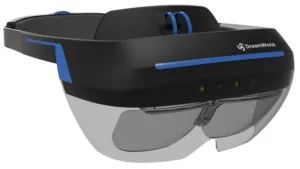The main purpose of the DreamGlass AR headset, as stated by the maker of the device, two year old start-up DreamWorld (San Mateo, CA), is “to provide AR developers with an accessible platform for creating high quality content.” The company goes on to explain that it is the company’s desire to make augmented reality “accessible to everyone” by offering a headset at a relatively affordable price.
One of the basic choices made early in the design of the DreamGlass was to offload much of the “infrastructure” needed to run the headset to an external device such as a PC or a smartphone. There are several consequences that follow directly from this choice including the following:
- When tethered to a PC, the user has limited mobility.
- When tethered to a smartphone, the user is able to move about.
- The smartphone can be used as a handy touch controller for the headset.
- One of the reasons that the solid plastic headset is light weight is that it does not have an internal battery, instead drawing power from the external device.
The headset includes an IR camera for inside-out tracking and hand gesture recognition. At this time, the headset can support 3 DoF head tracking. It also supports several major gestures such as swipe, pinch, hold, release and return. It will recognize gestures made by either hand.
Since the headset does not have positional and environmental tracking, it lacks “contextual information.” That is, with DreamGlass, it is only possible to position objects that, for example, float around the user’s head or are put on markers. Marker based 6 DoF positional tracking is reportedly under development.
Some of the specifications and features of the DreamGlass AR headset are as follows:
Display
- 90 degree diagonal field of view
- 1280 x 800 resolution per eye
- 60 Hz
- Front facing camera: 1080p RGB with microphone
- Audio: 3.5mm jack
- Weight: 240g (without cable)
Connectivity
- PC: two USB 3.0 + one HDMI 1.4
- Android: one USB type C
(With the USB type C, an in-line battery pack to power the headset is available as an optional accessory.)
Compatible Android smartphones
- Samsung: S8, S8 plus, Note 8, S9, S9 plus and Note 9
- Huawei: Mate 10, Mate 10 Pro, P20 and P20 Pro
(USB type C adapter required, iPhone/iPad support in development)
A video at the end of this article discusses the DreamWorld DreamGlass AR headset. The photograph below illustrates the headset.
The DreamWorld DreamGlass AR Headset.
As a first step, DreamWorld is releasing a DreamGlass Unity-based SDK that supports both Windows and Android. The company also plans a software distribution network to give developers a platform to sell their apps.
The DreamWorld DreamGlass AR headset is currently available for a price of $399 – which, at this time, is highly competitive for a headset having the features and specifications described above. This price is indicated as an early bird discount. The actual price of the DreamGlass AR headset is $619. The company said that it already has an inventory of the headsets and expects to deliver the first batch of orders near the end of this month. -Arthur Berman

